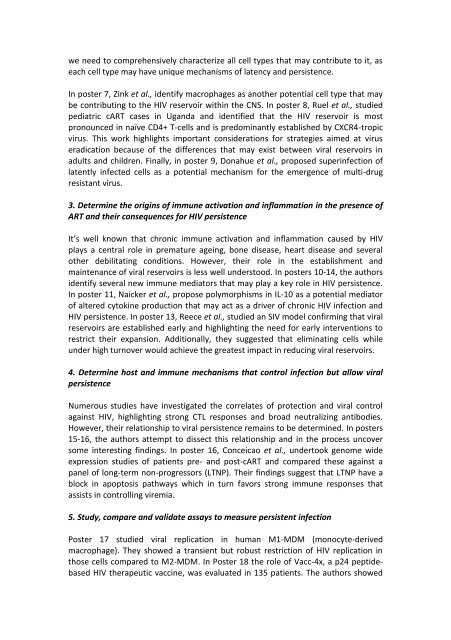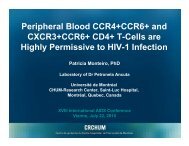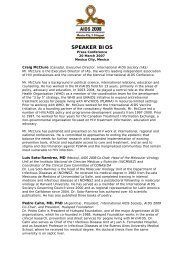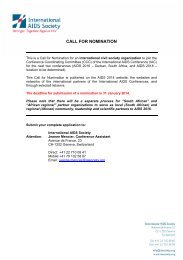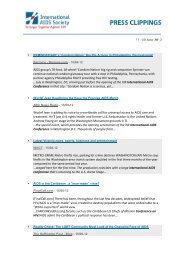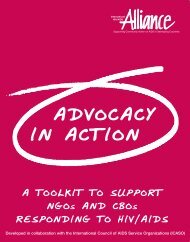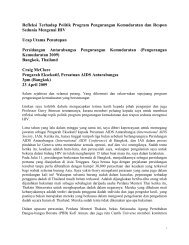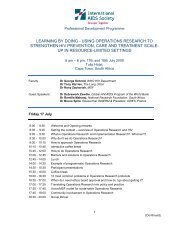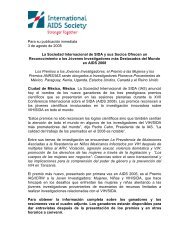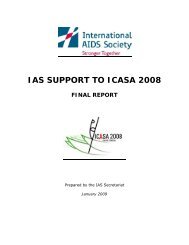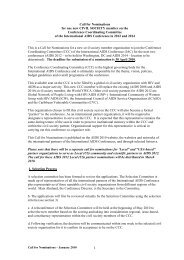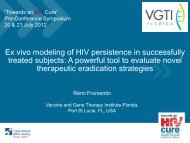Poster Exhibition - International AIDS Society
Poster Exhibition - International AIDS Society
Poster Exhibition - International AIDS Society
You also want an ePaper? Increase the reach of your titles
YUMPU automatically turns print PDFs into web optimized ePapers that Google loves.
we need to comprehensively characterize all cell types that may contribute to it, as<br />
each cell type may have unique mechanisms of latency and persistence.<br />
In poster 7, Zink et al., identify macrophages as another potential cell type that may<br />
be contributing to the HIV reservoir within the CNS. In poster 8, Ruel et al., studied<br />
pediatric cART cases in Uganda and identified that the HIV reservoir is most<br />
pronounced in naïve CD4+ T-cells and is predominantly established by CXCR4-tropic<br />
virus. This work highlights important considerations for strategies aimed at virus<br />
eradication because of the differences that may exist between viral reservoirs in<br />
adults and children. Finally, in poster 9, Donahue et al., proposed superinfection of<br />
latently infected cells as a potential mechanism for the emergence of multi-drug<br />
resistant virus.<br />
3. Determine the origins of immune activation and inflammation in the presence of<br />
ART and their consequences for HIV persistence<br />
It’s well known that chronic immune activation and inflammation caused by HIV<br />
plays a central role in premature ageing, bone disease, heart disease and several<br />
other debilitating conditions. However, their role in the establishment and<br />
maintenance of viral reservoirs is less well understood. In posters 10-14, the authors<br />
identify several new immune mediators that may play a key role in HIV persistence.<br />
In poster 11, Naicker et al., propose polymorphisms in IL-10 as a potential mediator<br />
of altered cytokine production that may act as a driver of chronic HIV infection and<br />
HIV persistence. In poster 13, Reece et al., studied an SIV model confirming that viral<br />
reservoirs are established early and highlighting the need for early interventions to<br />
restrict their expansion. Additionally, they suggested that eliminating cells while<br />
under high turnover would achieve the greatest impact in reducing viral reservoirs.<br />
4. Determine host and immune mechanisms that control infection but allow viral<br />
persistence<br />
Numerous studies have investigated the correlates of protection and viral control<br />
against HIV, highlighting strong CTL responses and broad neutralizing antibodies.<br />
However, their relationship to viral persistence remains to be determined. In posters<br />
15-16, the authors attempt to dissect this relationship and in the process uncover<br />
some interesting findings. In poster 16, Conceicao et al., undertook genome wide<br />
expression studies of patients pre- and post-cART and compared these against a<br />
panel of long-term non-progressors (LTNP). Their findings suggest that LTNP have a<br />
block in apoptosis pathways which in turn favors strong immune responses that<br />
assists in controlling viremia.<br />
5. Study, compare and validate assays to measure persistent infection<br />
<strong>Poster</strong> 17 studied viral replication in human M1-MDM (monocyte-derived<br />
macrophage). They showed a transient but robust restriction of HIV replication in<br />
those cells compared to M2-MDM. In <strong>Poster</strong> 18 the role of Vacc-4x, a p24 peptidebased<br />
HIV therapeutic vaccine, was evaluated in 135 patients. The authors showed


